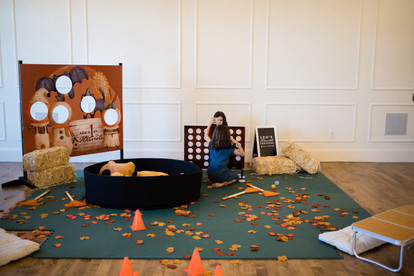I was not-so-secretly delighted to have an October baby, the best month, in the best season, Halloween to celebrate, all the pumpkin goodies and comfort food—I could go on and on! That made it easy to lean into as the theme for Leo's first birthday, starting with booking ArcLight in Oregon City as the venue because October weather in Oregon is notoriously unpredictable (side-note it ended up being in the 70's that day so we were happy to have AC). Working with my dream team at Confetti Friends PDX, everything came together seamlessly and really pumped everyone for an entry into fall!
All the following beautiful photos were captured by Bunn Salarzon.
Guests were greeted with a welcome display featuring hay bales, pumpkins, and favor bags on wood signs I crafted, including a 6 foot tall wall with shelves. Pairing the deep, dark green with the red and walnut accents and then having Amy Johnston work her magic with orange, yellow, peach and black balloons brought the whole piece together and feel more elevated than just using oranges, reds and yellows.

The next stop was a fall inspired charcuterie spread provided by the Hive Catering (inside Arc Light), complete with brie filled mini pumpkins, picked veggies, and a variety of meats and cheeses. It was a great light lunch for both the adults and toddlers in attendance!
And of course after lunch, dessert! Liz Marek with Sugar Geek Show created an AMAZING harvest dessert table with dozens of treats and filled in with fall fruits—the centerpiece being cake for Leo with edible pumpkins, and topper made by Devan McCabe with Olive and Apron. All the guests were extremely excited, and the kiddos enjoyed being able to fill up plates of all the mini desserts.

In between all the wonderful food, I wanted to create a Harvest themed play area as most of our guests were going to be toddlers. A ball pit, inflatable ponies, a rideable tractor and leaves with rakes kept all the kiddos busy while adults could sip sangria or beer and chat.
And when the kiddos needed a drink, we had a coco and hot cider bar set up for that extra fall cozy feeling.
After all the fun and games, guests received goody bags created and curated by Devan, who made sugar cookie kits complete with royal icing bags and fall themed cookie cutters! It was so fun a few days after the party to make the cookies and enjoy another small piece of Leo's day—even if he and his sister mostly just ate frosting.
The overall best part was celebrating that this little guy, who is such a funny and loving little character has been with us a whole year, and is just growing up far too fast!


Thank you to everyone who came out and celebrated Leo! It was so much fun to have our first real party post-pandemic and for those who hadn't met our sweet boy yet to finally squeeze him! Huge shout out to Liz, Devan, Amy, Bunn and Stephanie who made this event absolutely perfect, and are the core group of Confetti Friends PDX. A big thanks as well to the Hive and the ArcLight in Oregon City—a stunning venue that is versatile and just so worth the investment for any size gathering!
Credits below with IG profiles:
Party Concept / styling: @confettifriendspdx
Dessert display and cake: @sugargeekshow - Liz Marek
Signage and Harvest Playground: @Lettersanddust - Brittany
Favors and Cake Topper: @oliveandapron - Devan
Ballon Garland: @Johnstonstyle - Amy
Photos: @bunnsalarzon - Bunn
Food: @Thehivecateringco
Venue: @Thearclightvenue































































































